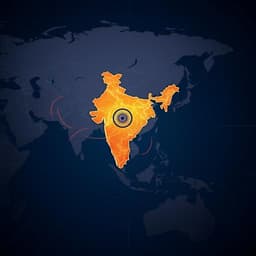
Earth Sciences
Anthropogenic warming and intraseasonal summer monsoon variability amplify the risk of future flash droughts in India
V. Mishra, S. Aadhar, et al.
Flash droughts threaten agriculture in India, particularly during the summer monsoon. Researchers Vimal Mishra, Saran Aadhar, and Shanti Shwarup Mahto reveal alarming projections that suggest a significant increase in drought events due to climate change and monsoon variability.
~3 min • Beginner • English
Introduction
The study investigates how anthropogenic warming and intraseasonal variability of the Indian summer monsoon influence the occurrence of flash droughts—rapid-onset soil moisture deficits that emerge over days to weeks. India’s agriculture and water resources are highly dependent on monsoon rainfall; conventional droughts tied to monsoon failure and large-scale climate modes like ENSO are well studied, but the drivers, frequency, and impacts of flash droughts in India are not. The purpose is to quantify historical flash drought characteristics and assess future risk under climate change, focusing on concurrent hot and dry extremes during the monsoon season, and to attribute changes to key forcings. Understanding these processes is critical because flash droughts can sharply increase irrigation demand during crop growth, stressing already depleted groundwater resources.
Literature Review
Prior work has documented Indian monsoon variability and its links to ocean–atmosphere drivers such as ENSO and IOD, and the translation of meteorological droughts into agricultural and hydrological droughts. Heat extremes and monsoon droughts have significant impacts on crop yields and water resources. Globally, literature on flash droughts highlights rapid soil moisture depletion driven by precipitation deficits, high temperatures, or both, with substantial agricultural impacts. In India, while causes and consequences of conventional monsoon droughts are well explored, flash droughts have received less attention. Studies also indicate increasing probabilities of hot extremes in a warming climate for India, suggesting potential for more concurrent hot–dry events. This study builds on these strands by explicitly characterizing flash droughts in India and their future evolution.
Methodology
Data: The study uses gridded daily precipitation (0.25°) and daily max/min temperature (1°, regridded to 0.25°) from the India Meteorological Department (IMD) for 1951–2016. Future and historical climate forcings are taken from the Community Earth System Model Large Ensemble (CESM-LENS; 40 members; 1°; 1920–2100; RCP8.5 for 2006–2100). Wind speed was also used from CESM-LENS. Atmospheric reanalysis fields (ERA-5) provided geopotential height (500 hPa), mean sea level pressure, wind (850 hPa), and integrated water vapor for 1979–2016.
Soil moisture simulation: Because CESM-LENS does not provide daily root-zone soil moisture, the Variable Infiltration Capacity (VIC v4.2) land surface hydrologic model was run at 0.25° over India in full water-balance mode using daily precipitation, max/min temperature, and wind speed as inputs. Vegetation parameters were from NOAA-AVHRR; soils from HWSD, with six soil parameters manually calibrated following prior work. A 20-year spin-up was used. The model simulates 0–60 cm root-zone soil moisture, evapotranspiration via Penman–Monteith, and other fluxes. VIC simulations were driven by IMD observations (1951–2016), by each of the 40 CESM-LENS members (1920–2100), and by single-forcing experiments (XGHG, XAER, XLULC) with 20, 20, and 5 members, respectively.
Flash drought identification: Soil moisture was aggregated to pentads (5-day periods; 73 per year). Monsoon season is pentads 30–55 (June–September). For each pentad, soil moisture percentiles were computed relative to 1951–2005 climatology using a Weibull empirical distribution. Drought was defined as soil moisture percentile (SMP) below the 20th percentile. Flash drought onset occurred when root-zone SMP declined from above the 40th percentile to ≤20th percentile with an average decline rate of at least 5 percentile points per pentad. Termination occurred when SMP rose to ≥25th percentile. Minimum and maximum flash drought duration were 3 and 18 pentads, respectively (to exclude persistent long-term droughts). For each event, duration, mean intensity (standardized anomaly), and areal extent were computed, and an overall severity score was defined as duration × intensity × area.
Atmospheric diagnostics: For identified flash droughts (1979–2016), composites of 500 hPa geopotential height, MSLP, 850 hPa winds, and integrated water vapor were created for pentads around onset, peak, and termination using ERA-5. Additional composites were constructed for extreme pentads: concurrent hot and dry (temperature anomaly > +1 SD; soil moisture anomaly < −1 SD) and concurrent wet and cool (soil moisture anomaly > +1 SD; temperature anomaly < −1 SD) during monsoon.
Future projections: Using VIC-driven soil moisture with CESM-LENS forcing, the study quantified 30-year moving mean frequencies (per year) of extreme dry pentads, extreme hot pentads, and concurrent hot–dry pentads over 1951–2100 (thresholds defined relative to 1971–2000). Frequencies of flash droughts meeting 1979-like benchmarks (duration >10 pentads, area >40% of India, mean intensity ≤ −1, overall severity >300) were computed across all ensemble members and time windows. Intraseasonal changes in monsoon (pentads 30–55) precipitation, temperature, and soil moisture were assessed for end-century (2071–2100) vs. 1971–2000.
Attribution via single-forcing experiments: The roles of greenhouse gases (XGHG: GHG fixed at 1920), industrial aerosols (XAER: aerosols fixed at 1920), and land-use/land-cover (XLULC: LULC fixed at 1920) were assessed by comparing frequencies of concurrent hot–dry monsoon pentads in each single-forcing ensemble to the corresponding ALL-forcing CESM-LENS members. Risk ratios (ALL divided by XGHG/XAER/XLULC) were computed over time.
Evaluation: VIC soil moisture anomalies were compared with GLEAM and ERA-5 products. CESM-LENS skill in monsoon precipitation seasonality and coupling with SST was assessed; known cool bias was noted but standardized anomaly-based thresholds reduce its impact for extremes estimation.
Key Findings
- Historical flash droughts: Fifteen flash droughts (1951–2016) all occurred during the summer monsoon (pentads 30–55). The 1979 event was the most severe, lasting ~10 pentads, affecting >40% of India, with strong positive temperature anomalies (>2 °C) and widespread precipitation deficits, particularly over the Indo-Gangetic Plain and eastern India. The longest lasted 16 pentads (1986). Ten of 15 events occurred after 1980, indicating an increased frequency in the post-1980 period.
- Atmospheric drivers: Composites show that peak flash droughts coincide with monsoon-break-like conditions: positive geopotential height and MSLP anomalies over land, weakened lower-tropospheric westerlies, and reduced integrated water vapor over India. Concurrent extreme hot and dry pentads exhibit similar atmospheric signatures, while wet and cool pentads align with active monsoon conditions.
- Future extremes (CESM-LENS, RCP8.5): By the late 21st century, relative to current levels, extreme dry pentads increase ~2.5×, extreme hot pentads ~6×, and concurrent hot–dry pentads ~4× (30-year moving means). Flash droughts meeting 1979-like thresholds increase by end-century by approximately: duration >10 pentads ~6×; area >40% ~8×; intensity ≤ −1 ~7×; overall severity >300 ~7–8×.
- Intraseasonal mechanism: Although seasonal mean monsoon precipitation increases by ~8–10%, intraseasonal shifts produce wetter early monsoon (pentads 30–42) but drier late monsoon (pentads 43–55). Combined with a ubiquitous +2–3 °C warming across monsoon pentads, late-monsoon root-zone soil moisture declines by ~3–4%, elevating flash drought risk particularly in the late monsoon.
- Attribution: Anthropogenic greenhouse gases substantially elevate concurrent hot–dry monsoon pentads; ALL vs. XGHG risk ratio reaches ~16–18 by late century. Removing industrial aerosols tends to increase temperatures, but the ALL/XAER risk ratio remains <1, indicating aerosols’ net effect differs from GHG dominance. LULC influence on concurrent hot–dry frequency is smaller than GHG in this framework.
- Implications: Increased flash drought risk threatens crop production, raises irrigation demand, and may intensify groundwater depletion in India.
Discussion
The study demonstrates that flash droughts in India are primarily triggered by monsoon breaks and are amplified by land–atmosphere feedbacks that enhance temperature anomalies and evapotranspiration, rapidly depleting root-zone soil moisture. By diagnosing both historical events and future projections, it addresses the central question of how anthropogenic warming and monsoon intraseasonal variability affect flash drought risk. Despite an overall projected increase in seasonal monsoon rainfall, late-monsoon drying at the pentad scale combined with robust warming leads to more frequent concurrent hot–dry extremes and thus many more flash droughts—up to 7–8 times more 1979-like events by century’s end. Attribution with single-forcing experiments isolates greenhouse gases as the dominant driver of the rise in concurrent hot–dry pentads, while aerosols and LULC play lesser roles in this setup. These findings are highly relevant for agriculture and water management, indicating increased irrigation demand during critical crop growth windows and potential exacerbation of groundwater stress.
Conclusion
This work provides the first comprehensive assessment of flash droughts in India using observation-driven hydrologic simulations and a large climate model ensemble. It identifies monsoon breaks and positive temperature anomalies as key drivers historically, highlights the 1979 event as the worst in the record, and projects large increases in concurrent hot–dry pentads and 1979-like flash droughts by late century under RCP8.5. The increase is linked to greenhouse-gas-driven warming and intraseasonal shifts toward late-monsoon dryness despite wetter seasonal means. The study underscores significant risks to crops, irrigation, and groundwater. Future research should: (i) evaluate multi-model robustness of intraseasonal monsoon changes and flash drought projections; (ii) integrate dynamic land-surface/vegetation responses to LULC changes; (iii) improve subseasonal prediction of monsoon breaks and land–atmosphere feedbacks; and (iv) assess adaptation strategies for irrigation scheduling and groundwater management under rising flash drought risk.
Limitations
- Model dependence: Projections are based on a single GCM (CESM-LENS); intraseasonal rainfall variability can differ across models, potentially affecting flash drought projections.
- Soil moisture representation: Root-zone soil moisture is simulated by VIC; long-term in situ observations are sparse. Though evaluated against GLEAM and ERA-5, uncertainties remain.
- Biases: CESM-LENS shows a cool bias; while standardized anomalies mitigate impacts on thresholding, biases may influence absolute values.
- ERA-5 availability: Atmospheric composite analysis is limited to 1979 onward due to reanalysis data availability.
- LULC treatment: XLULC experiments reflect LULC influence via meteorological forcing changes only; land-surface structural changes due to LULC within VIC are not explicitly represented.
- Flash drought definition: Results depend on chosen thresholds (percentiles, decline rate, duration caps) and pentad aggregation, which may affect event detection.
Related Publications
Explore these studies to deepen your understanding of the subject.







